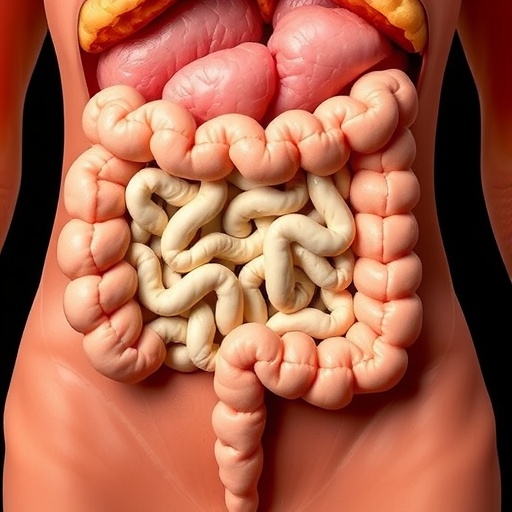In a groundbreaking advance that challenges conventional understanding of coeliac disease, researchers have unveiled a remarkable heterogeneity in the inflammatory landscape of the duodenal lining. This discovery emerged from an integrative analysis employing transcriptomics combined with expression quantitative trait loci (eQTL) mapping, shedding new light on the molecular complexity underlying this autoimmune disorder. Traditionally, coeliac disease has been viewed as a relatively uniform inflammatory condition; however, this innovative study exposes a spectrum of inflammatory states, revealing key variations that could revolutionize diagnostic and therapeutic strategies.
At the heart of this investigation is the duodenum, the initial segment of the small intestine critically involved in nutrient absorption and immune responses. In coeliac disease, gluten exposure triggers an aberrant immune reaction that inflames and damages this region, leading to a host of gastrointestinal and systemic symptoms. Yet, the precise molecular signatures and regulatory genetic factors that govern the intensity and character of such inflammation had remained elusive until now. By harnessing high-throughput RNA sequencing technologies alongside eQTL approaches, the research team effectively mapped gene expression profiles and linked them to underlying genetic variations, quantifying their influence on inflammatory pathways.
The transcriptomic data revealed diverse clusters of gene expression patterns among individuals diagnosed with coeliac disease, suggesting that patients do not manifest a single, monolithic inflammatory condition. Instead, distinct molecular subtypes characterized by different inflammatory mediators and immune cell signatures were evident. This heterogeneity aligns with the often variable clinical presentations and treatment responses seen in coeliac disease, offering a compelling explanation for why some patients experience more severe symptoms or refractory disease compared to others.
The application of eQTL analysis further illuminated how specific genetic variants modulate gene expression within the duodenal mucosa. These variants influence immune-related genes and pathways that orchestrate the inflammatory response to gluten, pinpointing genetic determinants that could predispose individuals not only to the disease itself but also to distinct inflammation profiles. Importantly, some of these eQTLs intersect with known loci implicated in autoimmune disorders, underscoring shared mechanisms and potential cross-disease insights.
What elevates the significance of this study is the integration of transcriptomic and genetic data to decode the complexity of immune activation in the duodenum. The researchers identified key cytokines, chemokines, and immune cell markers whose expression varied broadly among patients, indicating differential engagement of innate and adaptive immune responses. Among these, elements of the interferon signaling pathway and T-cell activation circuits were variably expressed, suggesting nuanced immune dysregulation that could be harnessed for personalized therapeutic targeting.
This layered understanding paves the way for novel biomarker discovery, potentially enabling clinicians to stratify coeliac disease patients based on their inflammatory signature. Such stratification could guide more tailored interventions, improving outcomes for those who do not respond adequately to a gluten-free diet or who experience fluctuating disease activity. The deployment of precision medicine approaches in coeliac disease, informed by molecular profiling as demonstrated here, represents a promising horizon in managing this autoimmune condition more effectively.
Moreover, the insights gained from this research extend beyond coeliac disease itself. The methodological framework combining transcriptomics with eQTL mapping offers a blueprint for dissecting inflammatory heterogeneity in other chronic inflammatory and autoimmune diseases that affect mucosal tissues. Understanding the interplay between genetic predisposition and gene expression dynamics within affected tissues could revolutionize how these complex disorders are classified and treated, ultimately improving patient care.
Another intriguing aspect uncovered involves the role of the epithelial barrier and its interaction with immune cells. Variations in gene expression related to epithelial integrity and repair mechanisms suggest that differential capacity for mucosal healing may contribute to the heterogeneity observed. These findings highlight the importance of tissue-specific factors and local microenvironment in shaping disease manifestations, underscoring that coeliac disease pathology encompasses more than just immune cell infiltration.
The researchers also provided compelling evidence that certain inflammatory pathways are selectively activated in subsets of patients, which might explain variations in symptoms such as diarrhea, malabsorption, and extraintestinal manifestations. For example, enhanced expression of genes associated with type 1 interferon responses correlated with a particular inflammatory subtype, potentially linking these molecular features to disease severity and chronicity.
Technically, the study leveraged cutting-edge RNA sequencing platforms capable of capturing subtle differences in gene expression, complemented by robust statistical models to associate these differences with genotypic variation. The multi-omics integration was essential to unravel the complex genotype-to-phenotype relationships that dictate disease heterogeneity, demonstrating the power of combining large-scale datasets to glean actionable biological insights.
The potential clinical implications of these findings are profound. Beyond stratification, the identified eQTLs and gene expression profiles could serve as targets for drug development or for repurposing existing therapies aimed at modulating specific inflammatory pathways. This could usher in an era where coeliac disease is managed not only by dietary elimination but also by precision immunomodulation tailored to the patient’s molecular profile.
Additionally, the study’s findings may have ramifications for screening and early detection. Genetic markers associated with specific inflammatory signatures could be used to identify at-risk individuals before symptom onset or to monitor disease progression and flare-ups, thus facilitating preemptive interventions. This preventative approach aligns with broader efforts in personalized medicine to shift healthcare from reactive to proactive.
The identification of transcriptomic heterogeneity also raises important questions about the environmental and microbial factors that may interact with host genetics to shape the inflammatory milieu. Future research building on this foundation may explore how the gut microbiome, diet, and other exposures influence these molecular phenotypes, potentially opening new avenues for modulating disease through lifestyle or microbiota-targeted therapies.
Furthermore, this work underscores the complexity of immune regulation in barrier tissues. The immune system’s balancing act between tolerance and activation is evidently influenced by a confluence of genetic and transcriptomic factors, contributing to the spectrum of tissue inflammation. As such, this paradigm could inform studies of other mucosal autoimmune diseases, including inflammatory bowel disease, providing a comparative understanding of shared and unique pathogenic mechanisms.
In conclusion, the integration of transcriptomics and eQTL analysis in this seminal study transforms our understanding of coeliac disease from a singular inflammatory entity into a mosaic of molecularly distinct subtypes. This enhanced resolution not only clarifies patient heterogeneity but also opens transformative pathways for diagnosis, treatment, and prevention. By charting the molecular diversity within the duodenal lining, the research heralds a new era of precision medicine for coeliac disease and potentially other mucosal autoimmune disorders, fulfilling a critical need in autoimmune research and clinical care.
Subject of Research: Transcriptomic and genetic analysis revealing inflammatory heterogeneity in the duodenal lining of coeliac disease patients.
Article Title: Transcriptomics and eQTLs reveal inflammatory heterogeneity in the duodenal lining in coeliac disease.
Article References:
Ramírez-Sánchez, A.D., Zühlke, S., Aguirre-Gamboa, R. et al. Transcriptomics and eQTLs reveal inflammatory heterogeneity in the duodenal lining in coeliac disease. Genes Immun (2025). https://doi.org/10.1038/s41435-025-00356-0
Image Credits: AI Generated
DOI: https://doi.org/10.1038/s41435-025-00356-0
Tags: autoimmune disorder research advancementscoeliac disease researchdiagnostic strategies for coeliac diseaseduodenal inflammation heterogeneityeQTL mapping in coeliac researchgastrointestinal symptoms of coeliac diseasegene expression profiling in coeliac diseasegluten-induced immune responseinflammatory diversity in coeliac diseasemolecular complexity of coeliac diseasetherapeutic implications of inflammatory diversitytranscriptomics in autoimmune disorders





